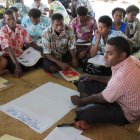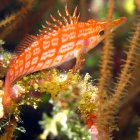By: Naomi Martin
Send to a friend
The details you provide on this page will not be used to send unsolicited email, and will not be sold to a 3rd party. See privacy policy.
Efforts to protect precious marine biodiversity by combining science and local knowledge are difficult but can work, reports Naomi Antony.
Along the coastline of Fiji, threatened fishing communities have been combining the ancient and the new in their fight to conserve precious marine resources.
Together with traditions remembered from centuries ago and community approaches to marine management, they are harnessing modern science to regain their livelihoods, and contribute to international efforts to safeguard the oceans.
But finding a balance between the local and the scientific has proved tricky. Without science, communities risk pursuing practices that have little long-term impact. But too much science can trample on a community’s way of doing things — destroying the morale that lies at the heart of local conservation.
Tension over tactics
Ten villages in Fiji’s Kubulau District have worked with the Wildlife Conservation Society’s (WCS) Fiji Program, along with the World Wildlife Fund and Wetlands International, to create the country’s first science-based network of marine protected areas.
The aim was to increase fish biomass in the area — to provide food for the communities and maintain biodiversity along the coastline — by establishing a network of areas where fish are either left completely alone or fished only under tightly controlled conditions.
The project combined traditional methods frequently used in the region’s locally managed marine areas (LMMAs) — near-shore areas managed locally by coastal communities, non-governmental organisations and government representatives — with the science of ‘ecosystem-based management’ (EBM), which considers ecosystems holistically, recognising the interactions between humans and their environment.
In 2008, when WCS marine conservationist Stacy Jupiter arrived in Fiji to take over the then three-year-old project, she found that there was disagreement about how it should proceed.
"There were conflicts between LMMA project partners who were in favour of the [existing] local, low-tech, low-cost way of doing things and the [people behind] the EBM project, which came in with quite a lot of money, throwing all kinds of science at LMMAs to see if they were working."
Jupiter and her colleagues "took a strategic pause" to assess the effectiveness of the science being used by the programme, which is funded by the Packard and Moore Foundations.
Ancient techniques are not enough

Community-based projects have proliferated since the 1990s
Stacy Jupiter
Some of the protected areas in Kubulau revive traditional practices to maintain food security that had served their ancestors for generations: temporary no-take — or ‘tabu’ — areas and seasonal bans on fishing.
"The concept of a tabu zone has hundreds of years of history," says James Comley, a research advisor with the Institute of Applied Science at the University of the South Pacific in Fiji.
"When a high chief passed away, a section of the reef would be closed for 100 nights to allow the fish to re-aggregate. At the end of that period it would be reopened and fished for a celebratory feast to commemorate the passing of the chief."
This approach depends on a tenure system in which communities retain the right to own or control an inshore area.
But local tenure systems gradually disintegrated in the twentieth century as populations moved, World War Two disrupted normal life, and communities began to practise Western economics and governance.
The 1990s saw a renaissance of community-conserved areas and a proliferation of community-based projects. Conservationists agreed the term ‘LMMA’ to define community ecosystem management at a meeting in Asia in 2000.
However, traditional practices and community-based initiatives are insufficient today, says Comley. Populations have grown, he says, and modern fishing methods along with coastal sediment run-off, climate change and deforestation threaten ecosystems in ways that didn’t exist a couple of hundred years ago.
"The fishery itself is just one of the threats to the marine environment," says Comley.
Jupiter agrees. For example, while many communities recognise the benefits of closing parts of their fishing areas, they’re not necessarily willing to leave them permanently closed.
"So they harvest them periodically, and they often harvest them a lot more than they tell their government or management partners," says Jupiter. "Five years of hard work is wiped out in two weeks."
Where science comes in
Jupiter says that science could be useful for pinpointing to what extent traditional practices can be used.
For example, one question that needs answering is how many fish can be taken now without compromising future food security. "We need scientific tools to be able to pinpoint that threshold and at the moment we’re not there," says Jupiter.



Fish biomass in Kubulau’s Namena Marine Reserve has been consistently high
Stacy Jupiter
Science is also being used to determine whether networks of protected areas improve wider biodiversity conservation and fisheries management. Traditionally, research has answered ‘no’ to this question, says Comley, but this is starting to change.
"This is what scientists are looking into at the moment in Fiji," says Comley. "How does this network of small protected areas add up in totality to a national network of protected areas? What percentage of habitats are protected, what are some of the critical ecosystem services and pathways that are protected?"
He says an impressive 30 per cent of individual areas in Fiji are now under some form of protection, compared with an "exceedingly small" percentage before the establishment of the LMMA Network.
However, these systems are effective only under certain conditions: spawning fish must be protected, and zones must either remain permanently closed or periodic harvesting must be carefully controlled.
Lessons from Kubulau
Overall the Kubulau District project has been "a big success", Jupiter argues, although data from before the project began is not of the quality or type of the more recent data, so a direct comparison is not possible.
Fish biomass in Kubulau’s Namena Marine Reserve has, however, consistently been observed to be approximately 1,000 kilograms per hectare greater than in adjacent fished areas between 2007 and 2009, though other reserves have been harder to assess.
Scientists have also seen a trend of increasing fish biomass in the parts of the managed areas that are open to fishing, suggesting a spillover from recovering no-fish areas.
Jupiter says that communities are more aware of the connections between their habitats, and the consequences of actions such as logging, on the ecosystem as a whole.
Kubulau’s network was completed, and endorsed by the district’s chiefs, in 2009. It was the first district to achieve the Fiji government’s commitment of protecting 30 per cent of its inshore and offshore waters.
Factors influencing the network’s success included the size of the no-take zones, their placement — for example in naturally productive habitats — and the level and length of protection.
Comley is a "firm believer" that marine science has had a positive impact on LMMAs, but he cautions that it has a specific, targeted role to play.
"The science needs to respect traditional beliefs and practices, it should never be used to supercede traditional practices."
In the majority of cases, he says, there is an issue of "nice to have versus need to have" surrounding the use of scientific tools. For example, some scientific approaches are of limited use when applied to small marine reserves, and only become critical on a national or regional scale.
Some of the most effective uses of research on a local scale have been the simplest, he adds. For example, he and his colleagues have recently been involved in looking at how protected areas affect ‘phase shifts’, where coral reefs degrade from coral-dominated to seaweed-dominated.



The longnose hawfish is one of many species benefiting from Kubulau’s community management
Stacy Jupiter
The protected areas have more algae-eating fish than the non-protected areas. When the researchers put lumps of seaweed into the protected areas, they saw the abundant algae-eating fish eating the seaweed and "acting to get the environment back to a healthier, coral-dominated state".
"It’s such a simple, incredibly clear-cut picture. Most importantly, it was visually demonstrable — we were able to use underwater video cameras to film what happened."
Hugh Govan, an independent consultant and technical advisor for the LMMA Network, echoes the point that simple, targeted, appropriate science has been invaluable in ensuring that sound, "good practice" advice reaches communities, as well as helping them assess what is working.
"Depending on the quality and uptake of this advice, communities have needed little else to establish effective systems — this is largely because it seems that the keys to success are more social and governance related," he adds.
It works both ways
But the process has not always run smoothly. "[Some] LMMAs have been let down not so much by science but by scientists," says Govan.
A scientific mindset that information must be gathered before there is any attempt to manage an area has led to too much investment in surveys and preliminary research, he says, missing the point that LMMAs are managed locally.
Such a mindset also doesn’t take into account the complexity of tropical Pacific reefs.
"Far simpler [ecosystems] with strict top-down management have defied us elsewhere in the world," he says.
As a local, Etika Rupeni, who works with the Asia-Pacific LMMA Network and is regional programme manager at Foundation of the Peoples of the South Pacific, has seen the rise and fall of these debates.
"We can’t really do science without good community-based management," he says, "and community-based management processes need to be informed by good science".
The key to it all, he says, is to answer the question: ‘What is the minimum science that a community needs to do its own management?’
And thus, it seems, that science has developed a healthy respect for the local ways of doing things — and vice versa.
The challenge for communities has been to find the most effective way of rebuilding ancient practices, developing approaches that are compatible with their contemporary needs and limitations — and listening to the scientists along the way. The challenge for the scientists has been to be humble about what they can contribute — both in theory and in practice — while making a difference all the same.
It has been a story of mutual learning.
Naomi Antony is SciDev.Net’s assistant news editor.
This article is part of a Spotlight on Ocean science for sustainable development.













